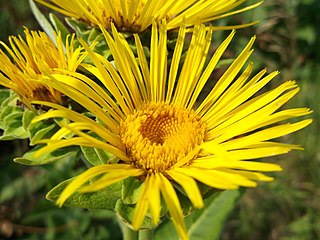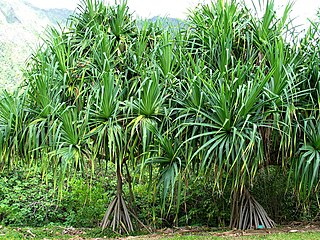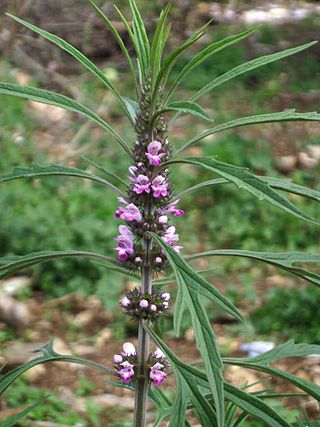
The veery is a small North American thrush species, a member of a group of closely related and similar species in the genus Catharus, also including the gray-cheeked thrush, Bicknell's thrush, Swainson's thrush, and hermit thrush. Alternate names for this species include Wilson's thrush and tawny thrush. Up to six subspecies exist, which are grouped into the eastern veery, the western veery or willow thrush, and the Newfoundland veery.

Elecampane, pronounced and also called horse-heal or elfdock, is a widespread plant species in the sunflower family Asteraceae. It is native to Eurasia from Spain to Xinjiang province in western China, and naturalized in parts of North America.

Pandanaceae is a family of flowering plants native to the tropics and subtropics of the Old World, from West Africa through the Pacific. It contains 982 known species in five genera, of which the type genus, Pandanus, is the most important, with species like Pandanus amaryllifolius and karuka being important sources of food. The family likely originated during the Late Cretaceous.

Elsholtzia ciliata, commonly known as Vietnamese balm, xiang ru (香薷) or kinh giới in Vietnamese, is a plant native to Asia. In the US, it is commonly known as Crested Late Summer Mint. In US Vietnamese grocery stores, it is called Kinh Gioi, Vietnamese Lemon Balm, or Vietnamese Lemon Mint.

Aster alpinus, the alpine aster or blue alpine daisy, is a species of flowering plant in the family Asteraceae, native to the mountains of Europe, with a subspecies native to Canada and the United States. This herbaceous perennial has purple, pink, or blue flowers in summer.

Leonurus sibiricus, commonly called honeyweed or Siberian motherwort, is an herbaceous plant species native to China, Mongolia, and Siberia. It has verticillaster inflorescence. It is naturalized in many other parts of the world, including South, Central and North Americas.

Amesiella is a genus of orchids endemic to the Island of Luzon, in the Philippines.

Amphipappus is a North American genus in the family Asteraceae. It is native to desert regions of the southwestern United States, in southern California, southern Nevada, Arizona, and southeastern Utah.

Butomus is the only known genus in the plant family Butomaceae, native to Europe and Asia. It is considered invasive in some parts of the United States.

The Pacific sea nettle, or West Coast sea nettle, is a common planktonic scyphozoan that lives in the eastern Pacific Ocean from Canada to Mexico.

Coelogyne barbata is a species of orchid. It is a shade-loving orchid that blooms in the months of October–November. It occurs in the Himalayas, Nepal, India, China and Myanmar. It grows epiphytic on trees or lithophyte on rocks in lower montane forests at an altitude of 1000 to 1800 meters above sea level. It is also found in Phalee but is rare. It has long, broad leaves and a bulb stem that grows from the roots. It blooms in September- November. It's a shade loving orchid.

Coelogyne cristata is an epiphytic orchid that comes from cool, moist areas of the eastern Himalayas and Vietnam. It blooms every spring, before the snow begins to melt. Its genus name Coelogyne originates from two Greek words, koilos ("hollow") and gyne ("woman"), because of the orchid's pistil. Cristata takes its species name from crista, the Latin word for "comb", because of the look of the flower's lip.

Cymbidium iridioides, commonly known as the Iris-Like Cymbidium is a species of boat orchid. It is a pseudobulbous epiphyte found from Himalaya to south-central China.

Gastrochilus distichus is a small species of orchid and pendant growing epiphyte. It is known by the common name distichous gastrochilus. It is found in Himalayas of India, Nepal, Bhutan, Assam, Sikkim, Tibet and Yunnan. It grows in the shade on moss covered rainforest at elevations of 1520–2700 m.

Robiquetia succisa, commonly known as The Abruptly Broken Off Robiquetia is a small to medium-sized species of pouched orchid found from eastern Nepal to southern China and Indochina.
Bulbophyllum spathulatum is a species of orchid in the genus Bulbophyllum. The plant is characterized by miniature flowers about 8x4 cm in size, and are a purplish red color. This plant is typically found in tropical climates at elevations of 1,000 to 2,000 meters, particularly in Asia.

Najas marina is a species of aquatic plant known by the common names spiny water nymph, spiny naiad and holly-leaved naiad. It is an extremely widespread species, reported across Europe, Asia, Africa, Australia, the Americas and many oceanic islands. It can be found in many types of freshwater and brackish aquatic habitat, including bodies of alkaline water.

Najas gracillima, the slender waternymph, is a submerged species of aquatic plant in the Hydrocharitaceae family. found in lakes and streams. It is native to China, Russian Far East, Japan, Korea, Taiwan, Iran, Alberta, Ontario, Newfoundland, Nova Scotia, New Brunswick, the eastern United States. It is also considered introduced and naturalized in France, Spain, Italy and California.

Peristylus constrictus is a ground orchid species from the genus Peristylus. It is found in Assam, Bangladesh, Myanmar, Thailand, Cambodia, the Himalayan region, Nepal, Vietnam and the Philippines. It produces fragrant white flowers in late spring or early summer.

Cymbidium faberi, commonly known as Faber's cymbidium is a species of boat orchid. It is a pseudobulbous geophyte found from Nepal to Taiwan and Myanmar.



















